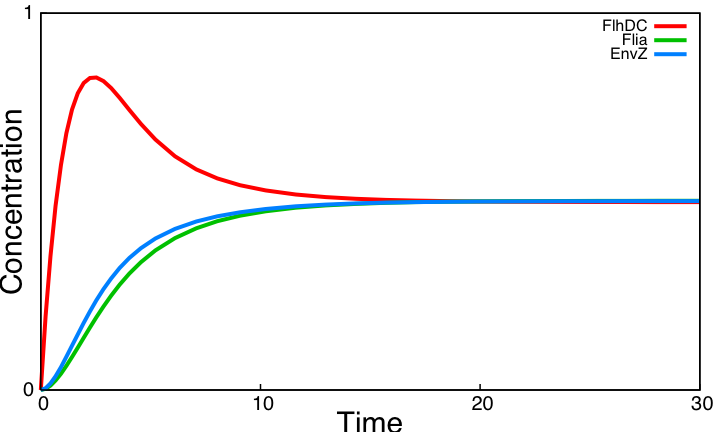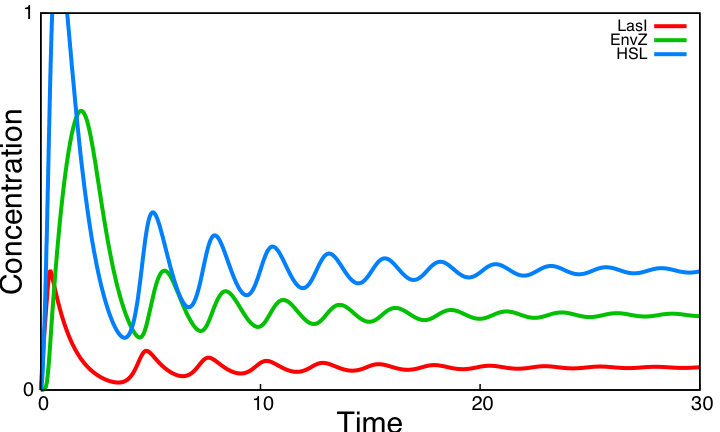Team:Paris/Network analysis and design/System improvements
From 2008.igem.org
(Difference between revisions)
(→System Improvements) |
|||
| (28 intermediate revisions not shown) | |||
| Line 1: | Line 1: | ||
| - | + | {{Paris/Menu}} | |
| + | {{Paris/Header|System Improvements}} | ||
| + | {{Paris/Section_contents_analysis}} | ||
| + | |||
| + | == Description == | ||
| + | |||
| + | |||
| + | == Analysis == | ||
| + | |||
| + | <center> | ||
| + | {| | ||
| + | |- style="background: #649CD7; text-align: center;" | ||
| + | | Name | ||
| + | | Description | ||
| + | | Evaluation | ||
| + | | Links | ||
| + | |- style="background: #dddddd;" | ||
| + | | style="background: #D4E2EF;"|Core system | ||
| + | | Figure core system | ||
| + | | [[Image:Core0.png|200px|center|Simulation of the core system]] | ||
| + | | Links core system | ||
| + | |- style="background: #dddddd;" | ||
| + | | style="background: #D4E2EF;" |Bimodular system | ||
| + | | Figure modular system | ||
| + | | [[Image:System4.png|200px|center|Simulation of the bimodular system]] | ||
| + | | Links Garcia-Ojalvo | ||
| + | |- style="background: #dddddd;" | ||
| + | | style="background: #D4E2EF;" |Unimodular system | ||
| + | | Figure resulting system | ||
| + | | [[Image:Oscillating.jpg]] | ||
| + | | Links resulting | ||
| + | |- style="background: #dddddd;" | ||
| + | !colspan="4" | Synchronized oscillations should be given by the unimodular system. | ||
| + | |}</center> | ||
| + | |||
| + | |||
| + | Core system does not oscillate. How can we enhance it? | ||
| + | |||
| + | We need a 'delay' so we can: | ||
| + | |||
| + | 1 add more genes to the circuit | ||
| + | |||
| + | 2 use quorum sensing (qs) | ||
| + | |||
| + | we chose quorum sensing that can allowed both 'delay' and population synchonization. | ||
| + | two ways to add it: | ||
| + | |||
| + | *S4: Inspired from Garcia-Ojalvo: oscillating repressilator + oscillating qs module = synchronized oscillations | ||
| + | |||
| + | *S2: it amounts to replace single interaction by more complex interactions: should create delay | ||
| + | |||
| + | we analyze both systems for their capacity to generate oscillations. | ||
| + | |||
| + | S2 seems more promising. | ||
| + | |||
| + | Thus we further analize S2 for its capacity to generate ''synchrionized'' oscillations (using different initial concentrations and cell populations variability). | ||
| + | |||
| + | == Conclusion == | ||
| + | |||
| + | == Navigation == | ||
| + | |||
| + | *[[Team:Paris/Network_analysis_and_design/System_improvements/Description|Description]] | ||
| + | |||
| + | *[[Team:Paris/Network_analysis_and_design/System_improvements/Analysis|Analysis]] | ||
| + | |||
| + | *[[Team:Paris/Network_analysis_and_design/System_improvements/Conclusions|Conclusion]] | ||
| + | |||
| + | <!-- | ||
| + | We first analyse S4 due to modularity. | ||
| + | |||
| + | damped oscillating core system + oscillating qs module = damped oscillations. | ||
| + | |||
| + | We continue with S2: | ||
| + | |||
| + | S0 module in S4 gived us insides in parameters analysis for S2. | ||
| + | |||
| + | given analysis results we keep S2. | ||
| + | --> | ||
Latest revision as of 00:42, 30 October 2008
|
System Improvements
Other pages:
DescriptionAnalysis
We need a 'delay' so we can: 1 add more genes to the circuit 2 use quorum sensing (qs) we chose quorum sensing that can allowed both 'delay' and population synchonization. two ways to add it:
we analyze both systems for their capacity to generate oscillations. S2 seems more promising. Thus we further analize S2 for its capacity to generate synchrionized oscillations (using different initial concentrations and cell populations variability). Conclusion
|
|||||||||||||||||||||
 "
"


